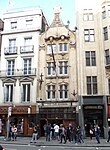Montagu House, Whitehall
Buildings and structures demolished in 1950Former houses in the City of WestminsterHouses completed in the 19th century

Montagu House in Whitehall, Westminster, London, England, was the town house built by John Montagu, 2nd Duke of Montagu (1690–1749), whose country seat was Boughton House in Northamptonshire.
Excerpt from the Wikipedia article Montagu House, Whitehall (License: CC BY-SA 3.0, Authors, Images).Montagu House, Whitehall
Great Scotland Yard, City of Westminster Covent Garden
Geographical coordinates (GPS) Address Nearby Places Show on map
Geographical coordinates (GPS)
| Latitude | Longitude |
|---|---|
| N 51.506388888889 ° | E -0.12638888888889 ° |
Address
Ministry of Defence Library
Great Scotland Yard
WC2N 5BX City of Westminster, Covent Garden
England, United Kingdom
Open on Google Maps










